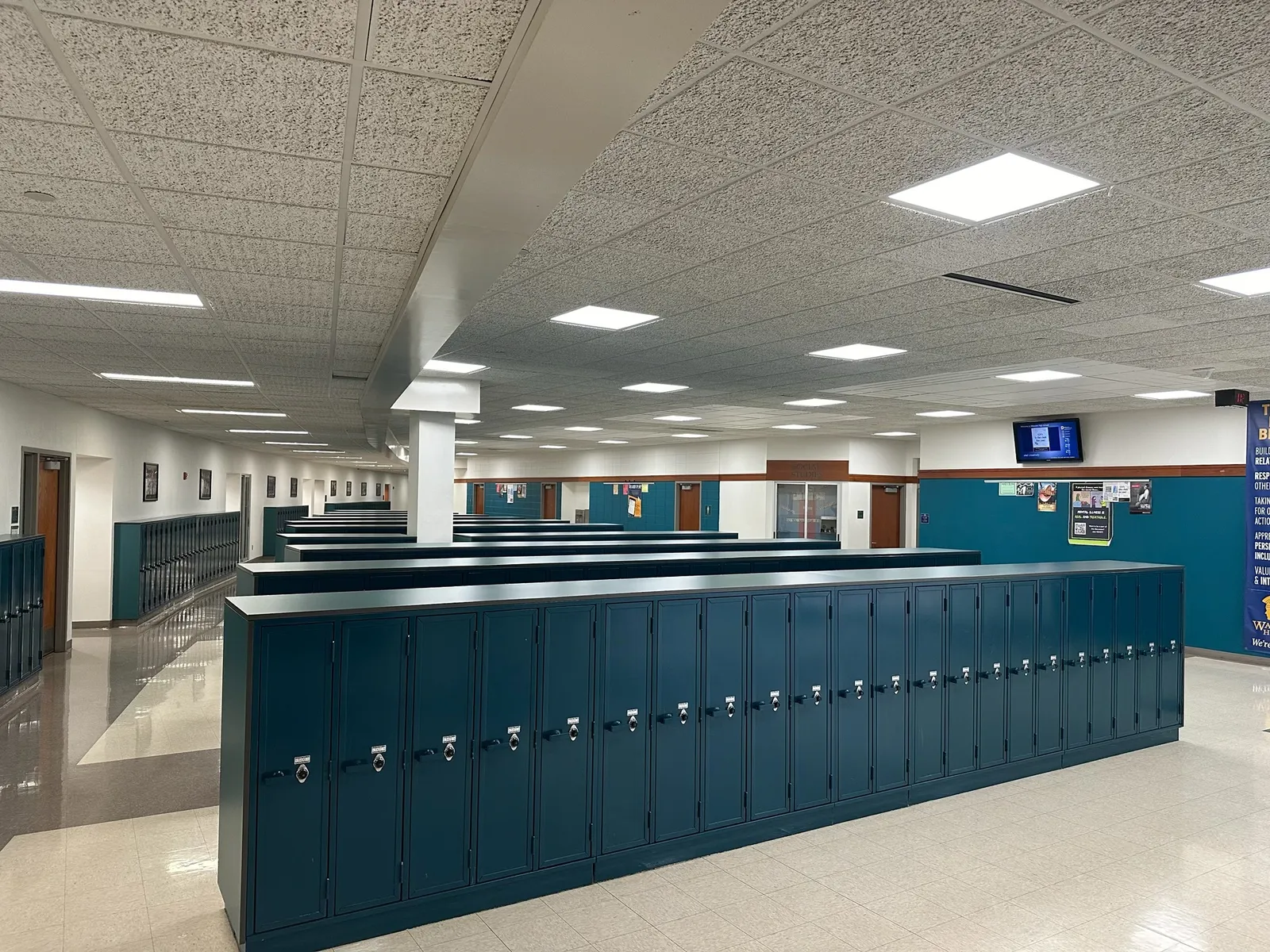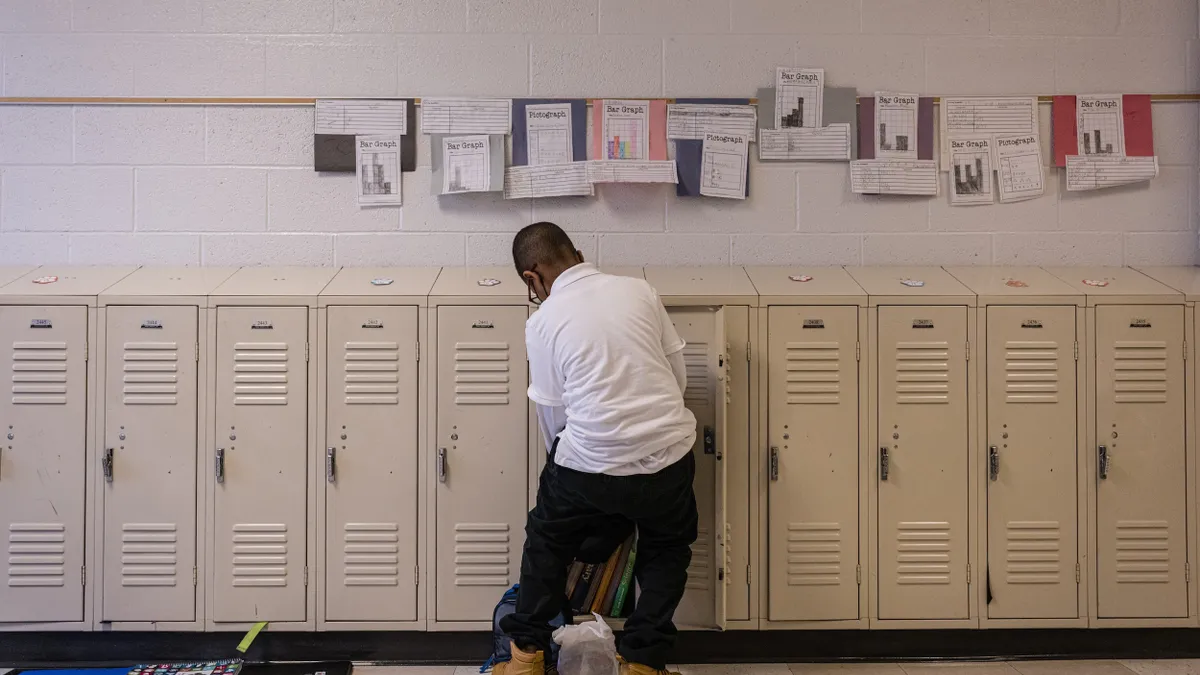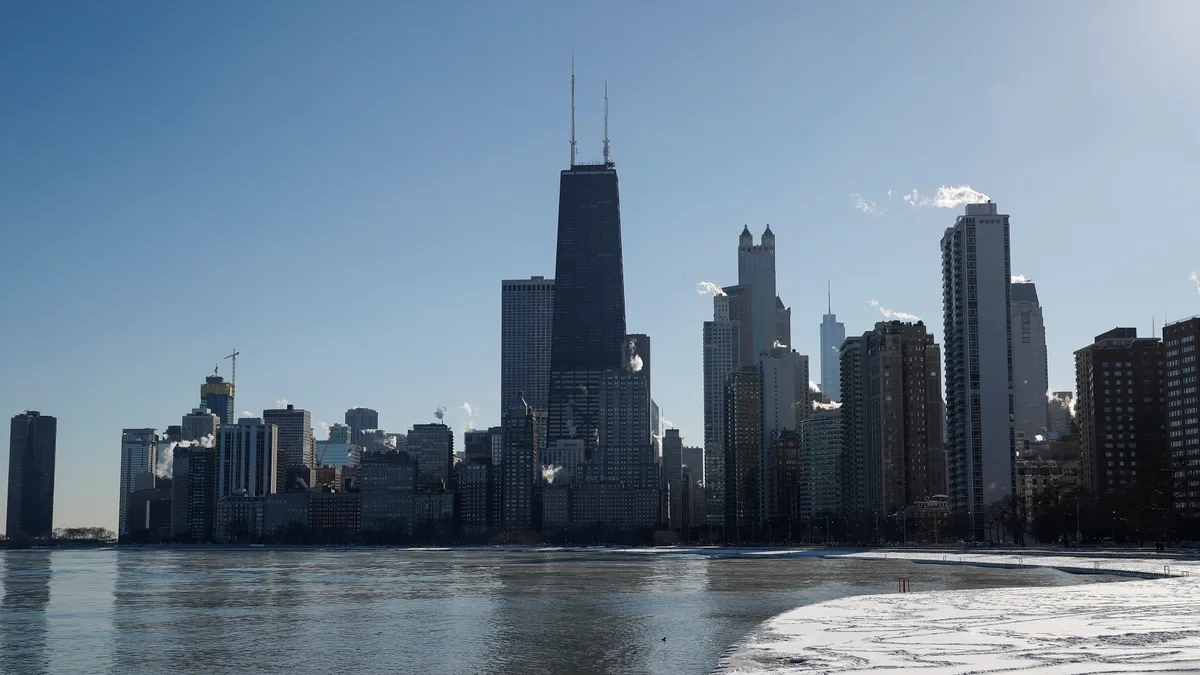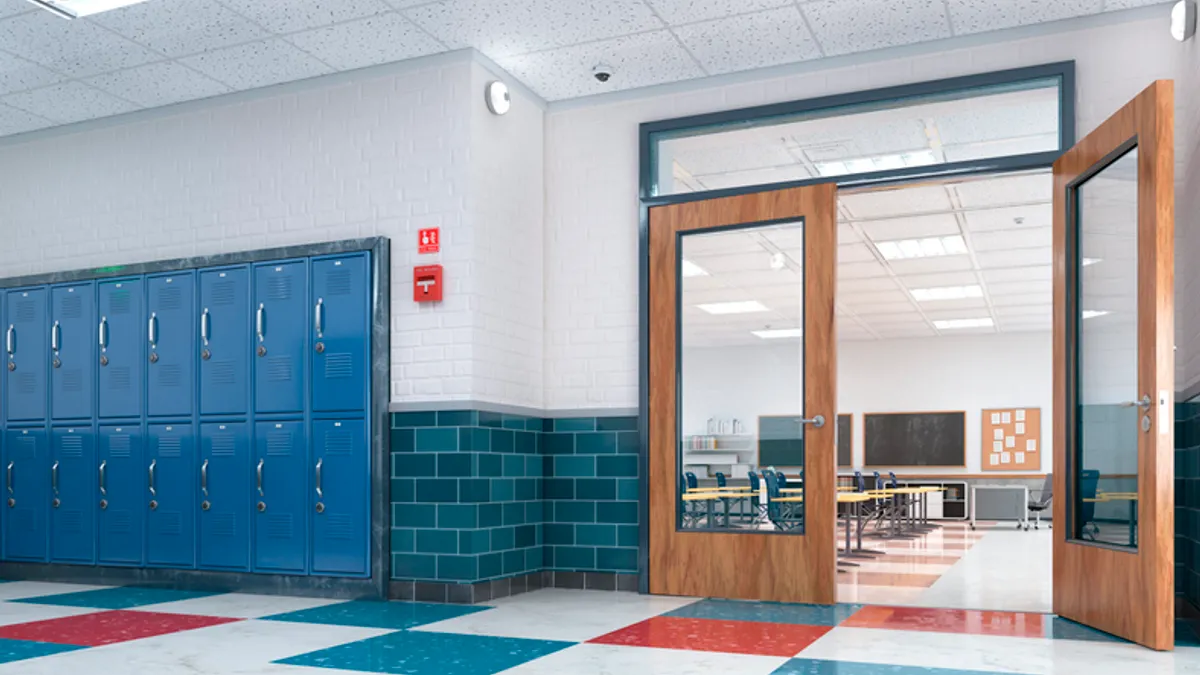The hallways at Wayzata High School in Plymouth, Minnesota, get pretty congested as 3,700 students pass through on their way to their next class. So when planning began for a floor renovation project recently, the school's leaders decided to permanently remove banks of floor-to-waist-high lockers that stood in rows in the middle of the hallways.
Although students congregate around the lockers for quick conversations with friends or to get a start on that night's homework, no one was actually using them for storage.
"Somewhere along the line our students generally felt there wasn't a high need or high demand for lockers," said Principal Scott Gengler. When Gengler started as the school's principal 10 years ago, 9th graders were assigned lockers but rarely used them. Now, all students are able to request a locker if they want — but only about 100 do so each year.
Like Wayzata High, schools across the country are removing lockers or forgoing the traditional practice of assigning every student a personal locker. Newly constructed high schools are more likely to be designed without the classic layout of lockers for every student, according to K-12 architecture experts. It's a trend that predates school closures due to COVID-19, but the pandemic helped herald their demise.
To the students, this makes sense as they never used their own lockers and see no need for one as many of their school resources and assignments are digitized. What they need for the day can be carried around in their backpacks.
Still, the trend is an emotional end of an era to educators and parents whose own high school memories are filled with decorating their lockers, passing notes through the lockers' vents and having a meeting point with friends during the school day.
People's memories of having lockers are usually pretty powerful, said Kipton Smilie, a professor of education at Missouri Western State University. Smilie wrote a paper about the disappearance of social spaces in high school with the declining use of lockers.
"A lot of our social lives at school revolved around these lockers," he said.
New uses for locker spaces
Of the five new construction middle and high school projects currently overseen by South Carolina-based architecture firm McMillan Pazdan Smith, none have the traditional locker-for-every-student model, said Ben Thompson, the firm's K-12 director and an accredited learning environments planner.
The declining desire for lockers is a trend that's been occurring for the past decade in the Southeast, Thompson said. He added that colleagues across the country also report similar shifts.
"It's more about how you design a facility for the best use that it can have."

Ben Thompson
K-12 director at McMillan Pazdan Smith
Rather than assuming every student needs a locker, architects and planners will ask school leaders if lockers are necessary for all students, for some or not at all. It's a question asked early in the design process because lockers, including room to open them, take up space in a hallway and can impact students' movement.
"They do affect the geometry of a corridor in a lot of ways," Thompson said.
McMillan Pazdan Smith is also working with Spring Valley High School in Columbia, South Carolina, which is planning to remove rows of waist-high lockers lined up in the middle of a hallway. In their place will be collaborative spaces featuring modern furniture that could be used for small or large group class project work or for socializing.
The aim is to make the space "more useful for what students are doing day in and day out," Thompson said.
Building a school without lockers for every student doesn't necessarily save money, he said. Although less square footage may be needed and there's less or no cost for lockers, there may be extra footage added to classrooms for storage cubbies or more space in hallways designated for collaborative spaces, he said.
There might also be activity-specific lockers for athletic programs and music or career and technical education classes.
"It's more about how you design a facility for the best use that it can have," Thompson said.
Tim Shimp, an educational learning designer with global design firm DLR Group and a former school superintendent, said the traditional use of lockers is waning with some schools turning to an on-demand model where students can request one if needed. But in some schools that limit backpacks in classrooms, students continue to use their lockers in the usual way, he said.
If and how students use lockers is "a large topic of conversation now when it comes to school design," Shimp said.
A plummet from popularity
There are several theories as to why the popularity of school lockers has plummeted. But the most common reason is the shift to 1-to-1 devices, electronic learning platforms and other digitized resources that allows students to carry everything they need for the day easily in their backpacks.
Students also say they have limited time between classes and don't want to go out of their way to stop at a locker. This "passing time" between classes is heavily managed by school administrators aiming to maximize instructional time while also making it logistically practical for students to make it to their next class on time.
Jane McAlpin, a senior at Arcadia High School in Phoenix, Arizona, said she has never used a locker in high school because she and other students were never given an option to have one — even though lockers line the school hallways.
Like her classmates, she carries all her books, notebooks and a laptop in her backpack. If students bring additional bags with sports equipment or other items, they tend to leave those bags in their first period classroom and come back for them at the end of the school day.
If McAlpin did have a locker, she might use it to store her textbooks. "But then again, I'm already running late to class sometimes because I have to run across campus," she said.
Another trend educators say contributes to the uselessness of lockers is teens’ tendencies to shun wearing coats.
Even at Wayzata High School in Minnesota, where winter temperatures often dip below freezing, Principal Gengler said he "still doesn't understand [why] our kids don't wear jackets."
He added that when he explains to new 9th grade parents that the school doesn't offer lockers to every student, the first question parents ask is where will their child put their coat.
Gengler then tells them, "Well, that's the next conversation you're going to have with your student."
Space for learning and socializing
As school leaders and design firms mull over opportunities to add collaborative work areas in spaces once reserved for traditional lockers, they are also prioritizing putting in flexible areas that teens would enjoy for socializing with friends.
That consideration is important given the role lockers have played in the social development and experiences of high schoolers in the past, said Smilie, the professor at Missouri Western State University.
"In the past, for those five minutes at least, you're interacting with people, whether you want to or not, but at least you were physically close to people and having to kind of navigate that."

Kipton Smilie
Professor of education at Missouri Western State University
Smilie's research led him to discover that high school lockers in the U.S. originally gained popularity after the 1918 flu pandemic as schools were trying to mitigate the spread of viruses and disease. Storing students' coats, book bags and lunch boxes in lockers helped with that effort. At the time, there was pushback by some who thought rows of steel lockers to be an eyesore, he said.
Over time, however, lockers became accepted appendages of school decor and even featured prominently in the late 20th century as props in movies about high school life. Still, some administrators feared that students could use their lockers to store illicit items.
Smilie said people's memories of their own days of high school lockers could include positive experiences like having a set meetup point with friends between classes or decorating a locker with a poster of a favorite band. They could also stir up negative experiences like bullying, lack of a connection with a social group, or anxiety over a forgotten locker combination, Smilie said.
Additionally, lockers served as forced social interactions and negotiation opportunities for students who had to share a locker or had to ask others in a crowded hallway to move over so they could get to their locker.
"In the past, for those five minutes at least, you're interacting with people, whether you want to or not, but at least you were physically close to people and having to kind of navigate that," said Smilie.
Thompson from McMillan Pazdan Smith said in current school architecture, community spaces are created for academic use with the added benefit of serving as social hubs.
"Kids are still kids," Thompson said. "They still desire to be around their peers and socialize, as well." When spaces can be designed for both instruction and socializing "that's the best," he said.

As for the lockers that were removed at Wayzata High, some were recycled, some were sold, and the rest will be redeployed to other buildings throughout Wayzata Public Schools.
Principal Gengler has been observing how students interact between classes now that lockers have been removed from two of the school’s four floors. In the hallways without lockers, there has been no difference in behaviors, he said.
"It hasn't changed the social dynamic at all," said Gengler.
He's considering putting high-top tables in the lockerless halls to encourage students to connect with peers between classes.
Now, if he could only get them to wear their coats.
Greg Linch, Data + Visuals Director, and Shaun Lucas, Visuals Editor, contributed to this article.








 Dive Awards
Dive Awards














